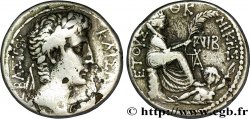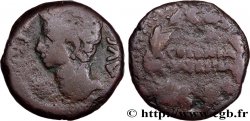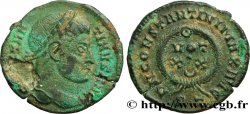v36_0356 - AUGUSTO Unité
MONNAIES 36 (2008)
Precio de inicio : 100.00 €
Valoración : 150.00 €
Precio realizado : 100.00 €
Número de ofertas : 1
Oferta más alta : 111.00 €
Precio de inicio : 100.00 €
Valoración : 150.00 €
Precio realizado : 100.00 €
Número de ofertas : 1
Oferta más alta : 111.00 €
Tipo : Unité
Fecha: 12 AC. - 14 AD.
Nombre del taller / ciudad: Acmonée, Phrygie
Metal: cobre
Diámetro: 18,5 mm
Eje de acuñación: 12 h.
Peso: 4,97 g.
Grado de rareza: R2
Comentarios sobre el estado de conservación:
Exemplaire sur un petit flan épais, bien centré des deux côtés, mais un peu court sur les légendes. Beau portrait. Faiblesse de frappe au revers. Patine marron foncé, légèrement granuleuse
Anverso
Descripción del anverso: Tête nue d’Auguste à gauche (O°1) ; devant la tête un lituus.
Leyenda del anverso: [S]EBASTOS
Traducción del anverso: (Auguste).
Reverso
Descripción del reverso: Niké (Victoire) drapée, marchant à droite, brandissant une couronne de la main droite et tenant une palme de la main gauche.
Leyenda del reverso: AKMONE[WN] - KORDOS
Traducción del reverso: (Acmonéon - Cordos).
Comentario
Pour ce type, les auteurs du Roman Provincial Coinage ont recensé six exemplaires avec six coins de droit, un poids moyen de 5,12 g pour quatre exemplaires. C’est le septième exemplaire signalé. Outre les deux exemplaires conservés à Londres, l’exemplaire du Cabinet des médailles de la BnF provient de la collection Waddington (n° 5484) et nous avons aussi un exemplaire à Berlin et un autre à Vienne. Le dernier est conservé au Staatliche museum de Münich. La présence du lituus devant le visage d’Auguste nous fait penser pour une datation postérieure à 13 avant J.-C. après la mort de Lépide quand Auguste recupère le titre de Pontifex Maximus (grand pontife), c’est à dire, chef de la religion traditionnelle romaine.
For this type, the authors of the Roman Provincial Coinage have identified six examples with six obverse dies, an average weight of 5.12 g for four examples. This is the seventh example reported. In addition to the two examples preserved in London, the example in the Cabinet des médailles of the BnF comes from the Waddington collection (no. 5484) and we also have one example in Berlin and another in Vienna. The last one is preserved at the Staatliche Museum in Munich. The presence of the lituus in front of the face of Augustus suggests a dating later than 13 BC after the death of Lepidus when Augustus recovered the title of Pontifex Maximus (high pontiff), that is to say, head of the traditional Roman religion.
For this type, the authors of the Roman Provincial Coinage have identified six examples with six obverse dies, an average weight of 5.12 g for four examples. This is the seventh example reported. In addition to the two examples preserved in London, the example in the Cabinet des médailles of the BnF comes from the Waddington collection (no. 5484) and we also have one example in Berlin and another in Vienna. The last one is preserved at the Staatliche Museum in Munich. The presence of the lituus in front of the face of Augustus suggests a dating later than 13 BC after the death of Lepidus when Augustus recovered the title of Pontifex Maximus (high pontiff), that is to say, head of the traditional Roman religion.








 Informar de un error
Informar de un error Imprimir la página
Imprimir la página Comparte mi selección
Comparte mi selección Haz una pregunta
Haz una pregunta Consignar / vender
Consignar / vender
 Descriptivo
Descriptivo















